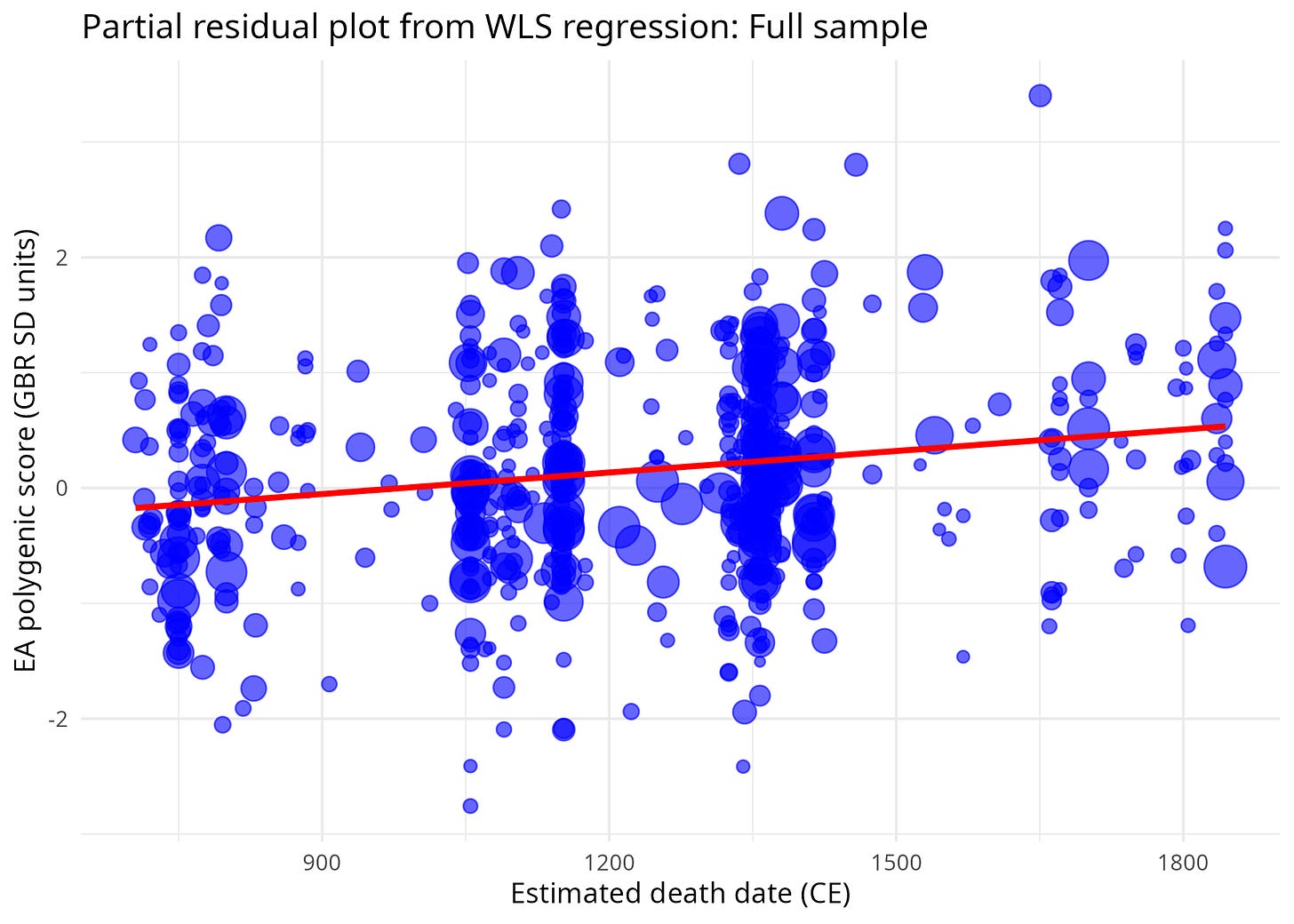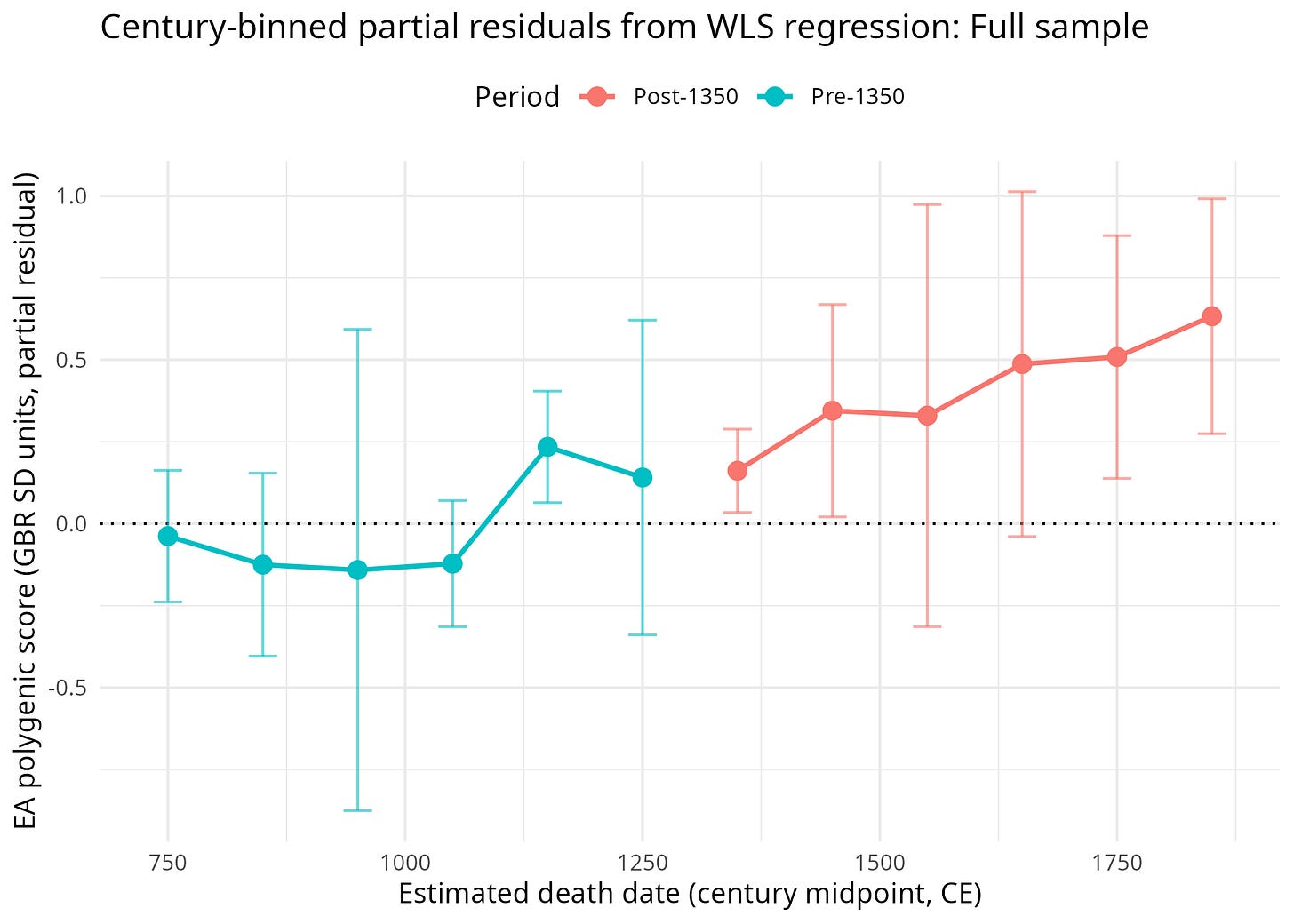The Genetic Evolution of the Human Race and Its Consequences for the Industrial Revolution
New genomic evidence for Clark’s theory
Why did the Industrial Revolution happen when and where it did?
The title of this blog post echoes a famous line about the Industrial Revolution, but here we turn it upside down.
Economic historians have offered a familiar menu of explanations:
cheap coal and high wages, better institutions, Enlightenment culture and science, trade and empire, and so on.
In our new paper, Genomic Evidence for Clark’s Theory of the Industrial Revolution, Prof. Gregory Connor and I explore a very different theory, one first proposed by Gregory Clark and only now testable with ancient DNA:
Before steam engines transformed the world, the human population that built them was already changing genetically.
Clark’s core claim is that, in preindustrial England, people with traits conducive to economic success such as higher cognitive ability, future orientation, thrift, self-control, had more surviving children. Over centuries, this created a slow but directional shift in the distribution of these traits. The mindset of the Industrial Revolution did not suddenly appear in the 18th century; it evolved.
Until recently, this was an elegant but untestable story. Now we can actually look into the genomes of people who lived between 700 and 1850 CE and ask: Was there a measurable genetic trend in traits linked to education and productivity?
The answer is most likely yes.
What we did
We assembled 600 ancient DNA samples from England, Belgium, Denmark, Germany, and the Netherlands. All individuals lived (and died) between 700 and 1850 CE.
Using large modern genome-wide association studies (GWAS) we computed polygenic scores for educational attainment (EA) for each ancient individual. Although “educational attainment” is a modern phenotype, the underlying genetic architecture reflects a mix of cognitive and non-cognitive traits that matter for learning, planning, impulse control, self-regulation, and motivation. These are exactly the traits that Clark identified as important in preindustrial economic life.
We then asked whether EA polygenic scores rise over time in these populations.
What we found
Across the full period from 700 to 1850 CE, we observe a statistically significant positive time trend in EA polygenic scores.
The total increase is about 0.78 standard deviations. This is not a small shift. Even moderate changes in the average of a normally distributed trait can strongly alter the upper tail. Using a simple model of score distributions, we find:
The number of individuals with an 1850-level “top 5 percent” EA score is more than six times greater in 1850 than in 700, assuming identical population sizes.
The number with an 1850-level “top 1 percent” score is more than ten times greater.
The upper tail is where inventors, engineers, innovators and highly skilled artisans come from. A substantial shift in that tail is consistent with Clark’s view that the Industrial Revolution did not spring from nowhere. It arose in a population that had gradually become more oriented toward learning, planning, literacy, and complex cooperation.
A simple scatterplot of raw EA polygenic scores against death dates would be misleading, because our scores are also affected by factors such as imputation quality, coverage, and which study a sample comes from. To isolate the time trend, we first fit a weighted least squares regression of EA PGS on estimated death date, imputation variance, coverage, and sample dummies.
From this regression we then computed partial residuals for death date. For each individual, we took the residual from the full model and added back the fitted linear contribution of death date. In effect, we kept the estimated effects of imputation variance, coverage, and study constant, and only let the time component vary. This gives a view of the relationship between EA PGS and date that has been adjusted for the main technical and sampling artefacts.
Figure 1 shows these partial residuals plotted against estimated death dates, together with the fitted regression line. The points are noisy, as expected with ancient DNA, but the slope of the red line is clearly positive. This is the same underlying trend that appears in the regression tables, now visualized after controlling for coverage, imputation quality, and sample differences.
Figure 1.

When we aggregate the same data by century and look at mean scores with confidence intervals, we see the same gradual upward drift, which confirms that the pattern in Figure 1 is not driven by a few outlying individuals.
Figure 1 already suggests a modest upward drift in EA polygenic scores over time once we adjust for coverage, imputation quality, and sample differences. In Figure 2 we make this pattern clearer by aggregating the partial residuals by century. For each hundred-year bin we plot the weighted mean EA score and its 95 percent confidence interval, and we colour the points to distinguish pre-1350 from post-1350 centuries.
The result is a clean two-phase pattern. Before 1350 the century means fluctuate around a flat line with no clear upward trend. After 1350 the century means rise steadily, with higher EA scores in each successive period. The break between the turquoise (pre-1350) and coral (post-1350) segments mirrors our regression results and visually reinforces the idea that the positive time trend in EA PGS is concentrated in the post–Black Death period.
Figure 2.

The Black Death as a turning point
Taken together, the regression models and the century-binned plots tell a consistent story. The upward drift in EA polygenic scores is not a smooth, thousand-year trend. It is concentrated in the post-1350 period, and it is strongest in England, with much weaker trends in the continental subsample. In other words, the genomic signal of rising EA PGS is both late and geographically focused.
This pattern fits remarkably well with Clark’s demographic reconstruction from archival records. Between roughly 1250 and 1800 in England, higher-status and higher-income families had more surviving children, gradually shifting the population toward traits associated with economic success. Our genetic data provide an independent line of evidence pointing in the same direction: by the time we reach the early modern period, the English population looks increasingly enriched for alleles linked to educational attainment, while neighbouring regions show less pronounced change.
Could the Black Death have kickstarted cognitive evolution?
Our results show that the positive time trend in EA polygenic scores is concentrated in the centuries after the Black Death. This naturally raises a deeper question: why might a fourteenth-century plague have anything to do with cognitive evolution or “bourgeois” psychological traits?
There is a line of work in economic history that fits neatly with what we see in the genomic data. Gregory Clark’s demographic research shows that in pre-industrial England, higher-income families had more surviving children than poorer ones, and that this pattern persisted for centuries. The Black Death drastically changed factor prices and social conditions: labour became scarcer, wages rose, and land and capital became relatively cheaper. In that new environment, individuals who could exploit opportunities in trade, crafts, and skilled work had strong advantages.
Chi Pui Ho’s “Industrious Selection” model formalizes a similar idea at the macro level. He argues that, in agrarian societies, people who are more hardworking, future-oriented, and cooperative gradually out-reproduce those who are less so, and that the Black Death accelerated this process in late-medieval Europe by reshaping wages and the returns to effort and skill (Ho, 2016). The plague did not just kill randomly. It altered the economic game, and with it the kinds of behavioural and cognitive profiles that tended to thrive.
Our genomic findings can be read as a biological echo of this hypothesis. We do not claim that the Black Death instantly made Europeans smarter. Instead, we suggest that the post-plague economy may have amplified long-running selection on traits linked to educational attainment: learning ability, self-control, and long-term planning. In that sense, the Black Death looks less like a one-off catastrophe and more like a hinge in the evolutionary history of the populations that would later launch the Industrial Revolution.
Data quality, imputation, and uncertainty
Ancient DNA poses several challenges. Genomes often have low coverage and many missing genotypes. Death dates are uncertain and provided with confidence intervals. We address these issues directly.
We imputed missing genotypes with GLIMPSE2, using the 1000 Genomes reference panel.
We used expected genotype probabilities rather than simple hard calls.
We constructed an imputation variance measure that captures how uncertainty suppresses EA polygenic scores in poorly imputed genomes.
We used this measure to correct for heteroskedasticity and included it as a covariate.
We handled uncertain death dates with an errors-in-variables approach based on the reported radiocarbon confidence intervals.
One interesting result is that SNPs with poor imputation quality tend to include a slightly higher fraction of EA-increasing alleles. This means low-quality genomes have EA scores that are biased downward. After controlling for this, the time trend becomes clearer, not weaker.
Across all estimation strategies the core finding persists.
Implications for the history of the Industrial Revolution
Our interpretation does not replace the usual explanations for the Industrial Revolution. Institutions, literacy, coal, trade, scientific advances, and political stability remain central. Our point is that the populations navigating these opportunities had themselves been shifting genetically in ways that favored learning, foresight, and disciplined economic behavior.
Clark describes this population-level change as a “gradual progress toward a more rational and economically oriented mindset.” Our findings show that this mindset has a measurable genomic signature in the centuries that preceded industrialization.
A concise summary is:
The Industrial Revolution and its consequences were partly shaped by long-run genetic evolution in traits related to educational attainment and economic success.
Why we need more early modern DNA
Our sample contains 600 individuals, mostly from a limited set of regions and archaeological contexts. More data would strengthen or refine our estimates. The early modern period from 1300 to 1800 is especially underrepresented in current paleogenomic collections.
The implications extend beyond educational attainment. EA polygenic scores share genetic architecture with traits related to autism, schizophrenia, bipolar disorder, personality, and cognition. Time-series polygenic studies show that many of these traits have long-term directional trends over the past 12,000 years in Eurasia. If EA increased rapidly during the early modern period, related traits may have shifted as well.
A larger and more geographically diverse genomic dataset from this period would allow researchers to test these possibilities.
References
Ho, Chi Pui, 2016. “Industrious Selection: Explaining Five Revolutions and Two Divergences in Eurasian Economic History within a Unified Growth Framework,” MPRA Paper 73862, University Library of Munich, Germany.

